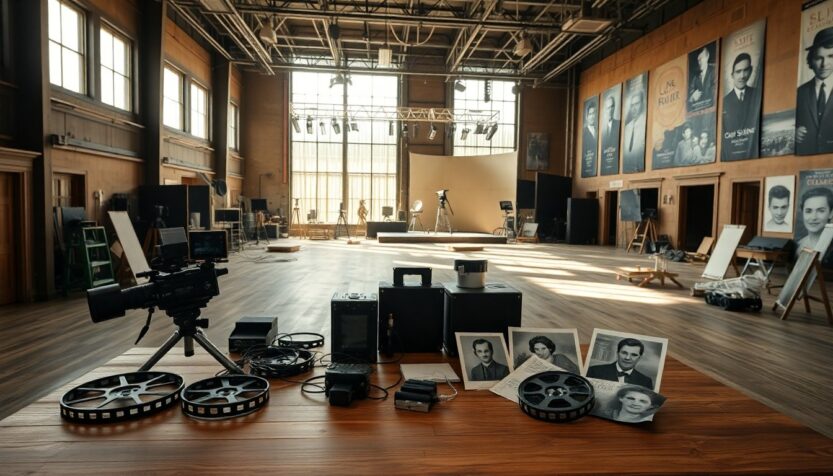In the heart of Los Angeles, Bryn Mooser operates from a historic soundstage that once echoed with the laughter of early cinema’s finest. Surrounded by artifacts of Hollywood’s illustrious past, Mooser recognizes the immense transformations the industry has undergone. From the silent films of Mabel Normand to the groundbreaking works of directors like Martin Scorsese, he draws inspiration from the walls that have witnessed the evolution of storytelling.
After just eight months at his current location, Mooser has established a vibrant workspace filled with creative minds harnessing the power of generative artificial intelligence. His company, Asteria, prides itself on being an artist-led generative AI film studio, aiming to bolster the art of storytelling rather than replace the storytellers themselves.
Innovating with AI in film production
Unlike many tech giants from Silicon Valley, Mooser approaches AI from a distinctly Hollywood perspective. He emphasizes the importance of resolving copyright issues before fully integrating AI into the creative process. To tackle this challenge, Asteria collaborated with Moonvalley, a tech start-up, to develop a new AI model named Marey, honoring the pioneering work of French cinematographer Étienne-Jules Marey. This model is designed specifically for filmmakers and exclusively utilizes legally licensed materials, making it a valuable tool for professionals in the industry.
The recent surge of interest in AI has generated both excitement and apprehension within Hollywood. Reports of AI-generated actors and the potential for misuse of digital likenesses have sparked debates among artists and industry leaders alike. The emotional impact of AI was poignantly illustrated when Zelda Williams, daughter of the late Robin Williams, publicly requested an end to AI-generated videos of her father, highlighting the ethical dilemmas that AI presents.
Facing the challenges of AI adoption
Despite the turbulent atmosphere surrounding AI, Mooser believes in the technology’s potential. He compares Asteria to a teaching hospital where newcomers can learn about AI’s capabilities without fear. Mooser is passionate about demystifying AI for those skeptical of its implications, promising that they will leave with a newfound understanding of its possibilities.
Reflecting on his experience, Mooser recalls the cold reception he received when discussing AI at the Sundance Film Festival two years ago. However, shifting cultural attitudes have made audiences more receptive to the technology, as everyday applications like ChatGPT have become commonplace. He notes a palpable change in those who visit his office, often expressing relief and curiosity rather than fear.
Collaborative projects and creative visions
Asteria’s innovative projects demonstrate how AI can coexist with traditional filmmaking techniques. For instance, when Bad Bunny sought to create a music video for his song “Ketu TeCré,” Asteria developed a model that allowed the team to efficiently produce stop-motion animations featuring a frog mascot named Concho, saving time without diminishing the role of artists.
Furthermore, Asteria has announced the upcoming animated short film ChikaBOOM!, directed by c. Craig Patterson and featuring notable voices like Natasha Lyonne and Yara Shahidi. Mooser also hints at a high-budget animated film that Asteria plans to produce for a fraction of the traditional cost, demonstrating the cost-saving potential of AI-driven production.
The duality of AI in the industry
While many creatives remain resistant to AI, fearing it may undermine their craft, Mooser advocates for a balanced approach. He acknowledges the concerns raised by luminaries such as Guillermo del Toro, who has expressed his disinterest in generative AI, but he believes that adapting to technological advancements can lead to new creative opportunities. Mooser envisions a future where filmmakers can tailor AI models to suit their specific projects, enhancing their artistic vision.
However, the integration of AI into Hollywood is not without its challenges. The environmental impact of AI technology, particularly its energy consumption, remains a critical concern. Mooser recognizes the need for sustainable practices as the industry navigates the complexities of this new era. He views this moment as a pivotal juncture, where the convergence of technology and artistry could revolutionize the filmmaking landscape.
Future prospects and the democratization of filmmaking
After just eight months at his current location, Mooser has established a vibrant workspace filled with creative minds harnessing the power of generative artificial intelligence. His company, Asteria, prides itself on being an artist-led generative AI film studio, aiming to bolster the art of storytelling rather than replace the storytellers themselves.0
After just eight months at his current location, Mooser has established a vibrant workspace filled with creative minds harnessing the power of generative artificial intelligence. His company, Asteria, prides itself on being an artist-led generative AI film studio, aiming to bolster the art of storytelling rather than replace the storytellers themselves.1
After just eight months at his current location, Mooser has established a vibrant workspace filled with creative minds harnessing the power of generative artificial intelligence. His company, Asteria, prides itself on being an artist-led generative AI film studio, aiming to bolster the art of storytelling rather than replace the storytellers themselves.2

